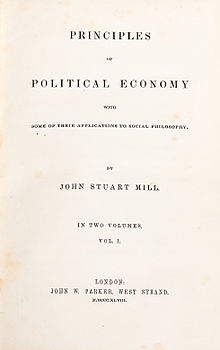Principles of Political Economy

Cover first edition, 1848
|
|
| Author | John Stuart Mill |
|---|---|
| Country | United Kingdom |
| Language | English |
| Subject | Political philosophy |
| Genre | Nonfiction |
| Publisher | John W. Parker |
|
Publication date
|
1848 |
| Media type | |
| Pages | 450 |
Principles of Political Economy (1848) by John Stuart Mill was one of the most important economics or political economy textbooks of the mid-nineteenth century. It was revised until its seventh edition in 1871, shortly before Mill's death in 1873, and republished in numerous other editions. Beside discussing descriptive issues such as which nations tended to benefit more in a system of trade based on comparative advantage (Mill's answer: those with more elastic demands for other countries' goods), the work also discussed normative issues such as ideal systems of political economy, critiquing proposed systems such as communism and socialism. Along with A System of Logic, Principles of Political Economy established Mill's reputation as a leading public intellectual. Mill's sympathetic attitude in this work and in other essays toward contemporary socialism, particularly Fourierism, earned him esteem from the working class as one of their intellectual champions.
Mill's Principles were written in a style of prose far flung from the introductory texts of today. Devoid of the mathematical graphs and formulae that were only developed after his death, principally by Alfred Marshall, Mill wrote with the rich tone of grandeur that is found in all his books. His book continued to be used well into the twentieth century as the foundational textbook, for instance in Oxford University until 1919.
Mill explores the nature of production, beginning with labour and its relationship to nature. He starts by stating, that the "requisites of production are two: labour, and appropriate natural objects." A discussion follows of man's connection to the natural world, and how man must labour to utilise almost anything found in the natural world. He uses a rich array of imagery, from the sewing of cloth, to the turning of wheels and the creation of steam. Man has found a way to harness nature, so that "the muscular action necessary for this is not constantly renewed, but performed once for all, and there is on the whole a great economy of labour." He then turns on the view of who "takes the credit" for industry. "Some writers," he says,
"have raised the question, whether nature gives more assistance to labour in one kind of industry or in another; and have said that in some occupations labour does most, in others nature most. In this, however, there seems much confusion of ideas. The part which nature has in any work of man, is indefinite and incommensurable. It is impossible to decide that in any one thing nature does more than in any other. One cannot even say that labour does less. Less labour may be required; but if that which is required is absolutely indispensable, the result is just as much the product of labour, as of nature. When two conditions are equally necessary for producing the effect at all, it is unmeaning to say that so much of it is produced by one and so much by the other; it is like attempting to decide which half of a pair of scissors has most to do in the act of cutting; or which of the factors, five and six, contributes most to the production of thirty."
...
Wikipedia
